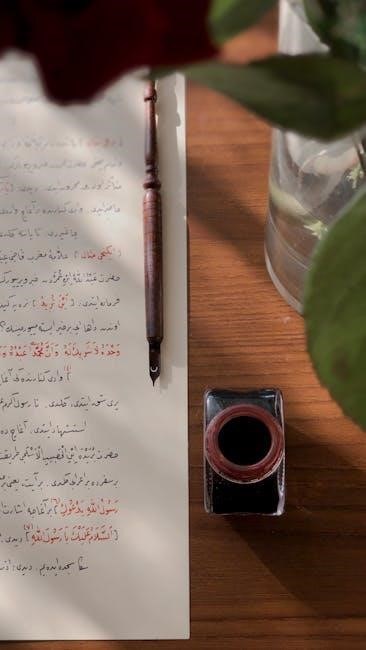Arabic Letters PDF: A Comprehensive Guide
Embark on a journey to master the Arabic script with our comprehensive guide․ This resource offers a structured approach to learning Arabic letters․ Explore forms‚ pronunciation‚ and practical exercises․ Downloadable PDF worksheets included for beginners to advanced learners‚ offering a pathway to fluency․
The Arabic alphabet‚ the foundation of the Arabic language‚ is a script rich in history and cultural significance․ Unlike the Latin alphabet‚ Arabic is written from right to left and consists of 28 letters․ Learning the Arabic alphabet is the first step towards understanding and appreciating the Arabic language and its literature․
The Arabic script is not merely a set of symbols; it’s an art form‚ with calligraphy playing a vital role in Islamic culture․ Each letter possesses unique characteristics and can change form depending on its position within a word – initial‚ medial‚ final‚ or isolated․ This feature adds complexity but also elegance to the writing system․
Understanding the phonetic values of each letter is crucial for accurate pronunciation․ While some letters have direct equivalents in English‚ others require practice to master․ This guide introduces the Arabic alphabet’s basic structure and provides resources‚ including PDF worksheets‚ to help beginners learn the alphabet․ These resources are designed to provide a solid foundation for further language studies․
Whether you are a student‚ linguist‚ or someone interested in Islamic culture‚ mastering the Arabic alphabet opens doors to a world of knowledge and beauty․
The 28 Letters: Forms and Pronunciation
The Arabic alphabet comprises 28 fundamental letters‚ each with its unique shape and sound․ Mastering these letters is the cornerstone of reading and writing Arabic․ Unlike English‚ Arabic letters can change form depending on their position in a word: initial‚ medial‚ final‚ or isolated․
Understanding these forms and their pronunciation is crucial for fluency․ Many Arabic letters have no direct English equivalent‚ requiring careful attention to articulation․ For example‚ the letter ع (ʿayn) represents a sound not found in English‚ demanding practice and guidance to pronounce correctly․
This section provides a detailed overview of each letter‚ including its various forms and phonetic values․ We offer clear pronunciation guides and examples to assist learners in mastering these sounds․ Furthermore‚ we emphasize the importance of recognizing how each letter connects with others‚ affecting its shape and pronunciation within different words․
Learning the Arabic alphabet is more than memorization․ It’s about understanding the system and the nuances of each letter․ Use the provided PDF worksheets to practice writing each letter in its various forms‚ reinforcing your understanding and improving your penmanship․ With dedication‚ you can unlock the beauty and complexity of the Arabic language․

Isolated Letter Forms
In Arabic script‚ each letter possesses a distinct isolated form‚ representing its standalone appearance when not connected to adjacent letters within a word․ This isolated form serves as the foundational representation of the letter‚ aiding learners in recognizing and differentiating each character․ Understanding the isolated forms is essential before progressing to the complexities of initial‚ medial‚ and final forms․
The isolated form allows learners to focus on the inherent shape of each letter without the added challenge of contextual variations․ It provides a clear visual reference‚ facilitating memorization and accurate reproduction of the letter’s structure․ Recognizing the isolated form enables students to build a solid foundation for understanding how letters transform in different contexts․
This section offers a comprehensive visual guide to the isolated forms of all 28 Arabic letters․ Each letter is presented with clear‚ concise illustrations‚ aiding visual learners in grasping the unique characteristics of each character․ Furthermore‚ this section includes practice exercises specifically designed to reinforce recognition and writing proficiency of isolated letter forms․
Mastering these forms is the first step towards fluency in reading and writing Arabic․ Through consistent practice and focused attention‚ learners can confidently identify and reproduce each isolated letter‚ paving the way for more advanced studies in Arabic script․
Initial Letter Forms
The Arabic script exhibits contextual variations in letter forms‚ and the initial form specifically refers to the shape a letter assumes when it appears at the beginning of a word․ Not all letters change drastically‚ but understanding these initial forms is critical for reading and writing fluency․ This section focuses on illustrating these initial forms and providing practical exercises․
Many Arabic letters connect to the subsequent letter in a word‚ influencing the appearance of the initial letter․ The initial form often involves a modification to facilitate this connection‚ typically involving a shortened or altered tail․ Recognizing these modified shapes is essential for accurate reading and writing․
This section provides a visual guide to the initial forms of each Arabic letter‚ highlighting the changes from their isolated forms․ Clear illustrations and examples demonstrate how each letter transforms when positioned at the beginning of a word․ Practice exercises‚ including tracing and writing prompts‚ are included to reinforce learning․
Mastering the initial forms of Arabic letters is a crucial step in developing reading comprehension and writing proficiency․ Through consistent practice and careful attention to detail‚ learners can confidently recognize and reproduce these initial forms‚ paving the way for advanced studies in Arabic script and language․
Medial Letter Forms
In Arabic script‚ the medial form of a letter is the shape it takes when it appears in the middle of a word‚ connected to letters on both sides․ This is a crucial aspect of Arabic writing‚ as many letters change their shape to facilitate seamless connections within words․ Understanding these transformations is essential for fluent reading and writing․
The medial form often involves modifications to both the beginning and end of the letter to allow for connection with preceding and following letters․ These changes can range from subtle adjustments to more significant alterations in shape․ Recognizing these variations is key to accurately identifying letters within words․

This section provides a detailed overview of each Arabic letter’s medial form‚ highlighting how it differs from its isolated‚ initial‚ and final forms․ Clear illustrations and examples of words showcasing these medial forms are included to aid comprehension․ Practice exercises‚ such as tracing and writing words with medial letters‚ are provided to reinforce learning․
Mastering the medial forms of Arabic letters is a significant step towards achieving fluency in reading and writing Arabic․ By understanding and practicing these forms‚ learners can improve their ability to decode and construct words accurately․ Consistent practice and attention to detail will help learners confidently navigate the complexities of Arabic script․
Final Letter Forms
The final form of an Arabic letter is the shape it takes when it appears at the end of a word‚ connecting only to the preceding letter․ Recognizing these forms is crucial for reading comprehension and accurate writing․ The final forms often differ significantly from the isolated forms of the letters․
Many Arabic letters change their shape when they appear at the end of a word to smoothly connect with the preceding letter․ This connection is a fundamental aspect of Arabic calligraphy and script․ The final form typically extends to the left‚ allowing for a connection with the preceding letter‚ while the right side of the letter remains unconnected․
This section provides a detailed explanation of each Arabic letter’s final form‚ highlighting the differences between the final form and the isolated‚ initial‚ and medial forms․ Clear illustrations and examples of words containing these final forms are included․ Practice exercises‚ such as tracing and writing words with final letters‚ are provided to reinforce learning․
Mastering the final forms of Arabic letters is essential for achieving fluency in reading and writing Arabic․ Consistent practice and careful attention to detail will enable learners to confidently recognize and use these forms․ Understanding these variations helps in accurately decoding and constructing words‚ ultimately enhancing overall proficiency in the Arabic language․
Vowel Signs and Symbols
Arabic vowel signs and symbols‚ also known as diacritics‚ are essential for indicating short vowel sounds‚ which are not represented by letters․ These signs are placed above or below the letters‚ aiding in pronunciation and comprehension‚ especially for learners; Understanding these symbols is crucial for accurate reading and speaking․
The primary vowel signs include the Fatha (َ)‚ representing the “a” sound‚ the Kasra (ِ)‚ representing the “i” sound‚ and the Damma (ُ)‚ representing the “u” sound․ Additionally‚ there is the Sukun (ْ)‚ indicating the absence of a vowel sound․ These diacritics can significantly alter the meaning of a word‚ making their correct usage vital․
This section provides a detailed explanation of each vowel sign‚ including its shape‚ pronunciation‚ and placement․ Examples of words with different vowel signs are included to illustrate their effect on pronunciation․ Practice exercises‚ such as reading words with vowel signs and identifying the sounds they represent‚ are provided․
Furthermore‚ this section covers other important symbols‚ such as the Shadda (ّ)‚ which indicates the doubling of a consonant‚ and the Madda (آ)‚ which represents a long “a” sound․ Mastering these vowel signs and symbols is crucial for accurate pronunciation and comprehension of written Arabic‚ enhancing overall language proficiency․
Learning Resources: PDF Worksheets for Beginners
To facilitate your journey into the Arabic alphabet‚ we provide a range of learning resources tailored for beginners․ These resources primarily consist of downloadable PDF worksheets designed to reinforce letter recognition‚ pronunciation‚ and writing skills․ The worksheets cater to diverse learning styles and paces‚ ensuring an engaging and effective learning experience․
The PDF worksheets include activities such as tracing letters‚ matching letters with their sounds‚ and filling in missing letters in words․ These exercises are designed to build a solid foundation in Arabic script․ The worksheets also feature visual aids‚ such as images and diagrams‚ to enhance understanding and retention․

For pronunciation practice‚ the PDF worksheets incorporate audio cues that can be accessed through QR codes or direct links․ These audio cues provide native speaker pronunciations of each letter and word‚ allowing learners to accurately mimic the sounds․
The worksheets are structured in a progressive manner‚ starting with the most basic concepts and gradually introducing more complex elements․ Regular use of these learning resources will significantly improve your ability to read and write Arabic letters․ Answer keys are provided for self-assessment and immediate feedback‚ further enhancing the learning process․
Tracing and Coloring Worksheets
Our tracing and coloring worksheets are meticulously crafted to offer an engaging and effective method for beginners to grasp the intricacies of the Arabic alphabet․ These worksheets combine the benefits of visual learning with kinesthetic practice‚ promoting better retention and understanding of letter forms․
Each worksheet features large‚ clear outlines of Arabic letters‚ allowing learners to trace over them repeatedly․ This tracing exercise aids in muscle memory development‚ essential for mastering the unique curves and shapes of each letter․ Additionally‚ coloring elements are integrated into the worksheets‚ providing an enjoyable and creative outlet that enhances engagement․
The coloring sections often include images associated with the letter’s sound or meaning‚ reinforcing vocabulary and contextual understanding․ For example‚ the worksheet for the letter “alif” might feature a picture of an “asad” (lion)‚ encouraging learners to connect the letter with a relevant word and image․
These tracing and coloring worksheets are available as printable PDFs‚ making them easily accessible for use at home or in the classroom․ The format is designed to be user-friendly‚ with clear instructions and ample space for practice․ Regular use of these worksheets will not only improve handwriting skills but also foster a positive attitude towards learning the Arabic alphabet․
Joining Letters Practice Sheets
Mastering the art of joining Arabic letters is a crucial step in becoming proficient in reading and writing the language․ Our joining letters practice sheets are specifically designed to help learners understand and practice this essential skill․ These sheets focus on how Arabic letters change form depending on their position within a word‚ whether initial‚ medial‚ or final;

Each practice sheet presents a variety of exercises that require learners to connect letters to form words․ These exercises start with simple two-letter combinations and gradually progress to more complex words․ The sheets provide clear examples of how each letter transforms when joined with others‚ highlighting the nuances of Arabic script․
The worksheets include dotted lines and guidelines to assist learners in accurately connecting the letters․ This helps in developing consistent and legible handwriting․ Furthermore‚ the practice sheets incorporate vocabulary relevant to beginners‚ ensuring that learners are not only improving their writing skills but also expanding their knowledge of Arabic words․
Available as printable PDFs‚ these practice sheets are easily accessible and can be used for self-study or in a classroom setting․ Regular practice with these sheets will enable learners to confidently join Arabic letters‚ improving their reading speed and writing accuracy․ This skill is fundamental for further studies in Arabic grammar and literature․
Advanced Topics: Grammar and Case Marking
Delving into advanced Arabic grammar involves understanding case marking‚ a system that indicates the grammatical function of nouns and adjectives within a sentence․ Case marking is crucial for accurate interpretation and construction of Arabic sentences․ This system uses vowel endings (harakat) or suffixes to denote nominative‚ accusative‚ and genitive cases‚ affecting word order and meaning․
In Arabic‚ the nominative case typically marks the subject of a sentence‚ the accusative case indicates the direct object‚ and the genitive case often denotes possession or follows prepositions․ These case endings are not always explicitly written in modern texts‚ requiring a strong understanding of grammar to discern the correct meaning․ For example‚ the word ‘kitab’ (book) can appear as ‘kitabun’ (nominative)‚ ‘kitaban’ (accusative)‚ or ‘kitabin’ (genitive)‚ each altering its role in the sentence․
Mastering case marking requires diligent study and practice․ It involves recognizing the patterns and rules that govern case endings‚ as well as understanding exceptions and irregularities․ Advanced learners often benefit from analyzing classical texts and engaging in extensive reading to internalize these grammatical concepts․
Understanding case marking enhances comprehension and fluency․ It enables learners to appreciate the subtleties of Arabic prose and poetry; This knowledge is essential for anyone seeking a deep understanding of the Arabic language and its rich literary tradition‚ it makes learning Arabic easier․
Mastering Arabic Letters
Achieving mastery of Arabic letters is a journey that combines consistent effort‚ dedicated practice‚ and the right resources․ As you navigate the intricacies of the Arabic alphabet‚ remember that each stroke and curve contributes to a rich linguistic heritage․ Embrace the challenge‚ and celebrate every milestone along the way․ Effective learning involves not just memorizing forms‚ but understanding their context within words and sentences․
The PDF worksheets and resources provided are designed to support your learning at every stage․ From tracing individual letters to practicing joined forms‚ these tools offer practical exercises to reinforce your understanding․ Remember to supplement your studies with authentic Arabic texts‚ audio materials‚ and cultural immersion to enhance your comprehension․
Mastery is not merely about flawless writing or perfect pronunciation; it’s about connecting with the language on a deeper level․ It’s about unlocking the ability to read‚ write‚ and communicate effectively in Arabic‚ opening doors to new cultures‚ perspectives‚ and opportunities․ Embrace the beauty and complexity of the Arabic script‚ and allow it to enrich your linguistic journey․
Keep practicing‚ stay curious‚ and let the Arabic letters be a gateway to a world of knowledge and understanding․ With dedication and perseverance‚ you will unlock the beauty and power of this ancient language; Your efforts will lead to proficiency and cultural appreciation․
